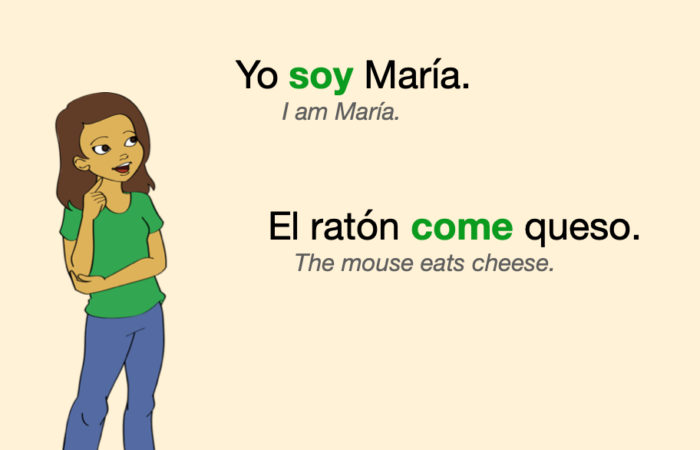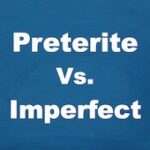Welcome 😊 to our grammar lesson on the Spanish Present Tense (“Presente de Indicativo”).
We use the Present Tense to state facts, and also to talk about habitual actions and events.

By the end of this lesson, you will be able to conjugate verbs in the present tense and use them in sentences.
You will also find a Quiz and Exercises to practice.
Contents
Regular and irregular verbs in Present Tense
There are 3 types of verbs in Spanish, looking at their ending:
- Verbs in “-ar”, such as “hablar”.
- Verbs in “-er”, such as “comer”.
- Verbs in “-ir”, such as “vivir”.
Unfortunately, the ending doesn’t say anything about a verb being regular or irregular. Every time we learn a new verb, we also need to learn if that specific verb is regular or irregular.
Conjugation of regular verbs
This is how we conjugate regular verbs:
- Remove the “-ar / -er / -ir”, leaving only the stem.
- Add an ending to that stem. The endings are different for verbs in “-ar”, “-er” and “-ir”. They are highlighted in green in the following table:
| Person | hablar to speak | beber to drink | partir to depart |
|---|---|---|---|
| yo | hablo | bebo | parto |
| tú | hablas | bebes | partes |
| él, ella, usted | habla | bebe | parte |
| nosotros, nosotras | hablamos | bebemos | partimos |
| vosotros, vosotras | habláis | bebéis | partís |
| ellos, ellas, ustedes | hablan | beben | parten |
Notice that… the endings for verbs in “-er” and “-ir” are different only for “nosotros” and “vosotros”.
Conjugation of irregular verbs
The endings in the table above still apply for most irregular verbs.
With that in mind, we divide irregular verbs into 4 types:
Verbs with a special “yo” form
The “yo” form is irregular, but the other persons are completely regular.
Examples:
| conducir to drive | conduzco, conduces, conduce, conducimos, conducís, conducen |
| conocer to know | conozco, conoces, conoce, conocemos, conocéis, conocen |
| dar to give | doy, das, da, damos, dais, dan (no accent mark on "dais") |
| hacer to do | hago, haces, hace, hacemos, hacéis, hacen |
| salir to go out | salgo, sales, sale, salimos, salís, salen |
| traer to bring | traigo, traes, trae, traemos, traéis, traen |
| ver to see | veo, ves, ve, vemos, veis, ven (no accent mark on "veis") |
Verbs with a stem change for all persons (except “nosotros” and “vosotros”)
The change can be one of the following:
- e or i becomes ie:
| cerrar to close | cierro, cierras, cierra, cerramos, cerráis, cierran |
| pensar to think | pienso, piensas, piensa, pensamos, pensáis, piensan |
| querer to want | quiero, quieres, quiere, queremos, queréis, quieren |
| adquirir to acquire | adquiero, adquieres, adquiere, adquirimos, adquirís, adquieren |
- o or u becomes ue:
| contar to tell | cuento, cuentas, cuenta, contamos, contáis, cuentan |
| poder can | puedo, puedes, puede, podemos, podéis, pueden |
| soñar to dream | sueño, sueñas, sueña, soñamos, soñáis, sueñan |
| jugar to play | juego, juegas, juega, jugamos, jugáis, juegan |
- e becomes i:
| pedir to request | pido, pides, pide, pedimos, pedís, piden |
| repetir to repeat | repito, repites, repite, repetimos, repetís, repiten |
| servir to serve | sirvo, sirves, sirve, servimos, servís, sirven |
- the letter y appears (for all verbs ending in -uir):
| construir to build | construyo, construyes, construye, construimos, construís, construyen |
| incluir to include | incluyo, incluyes, incluye, incluimos, incluís, incluyen |
Verbs with a special “yo” form AND a stem change for the other persons (except “nosotros” and vosotros”)
This third type is a like a mix of the previous types.
Examples:
| decir to say | digo, dices, dice, decimos, decís, dicen |
| tener to have | tengo, tienes, tiene, tenemos, tenéis, tienen |
| venir to come | vengo, vienes, viene, venimos, venís, vienen |
A few very irregular verbs
Here we include “ser” and “ir”, which don’t belong to any of the previous types.
Also “estar”, a peculiar verb because it has many accent marks in present tense.
Finally, “oler”. It follows the “o → ue” pattern, but also a letter “h” appears for most persons.
| ser to be | soy, eres, es, somos, sois, son |
| estar to be | estoy, estás, está, estamos, estáis, están |
| ir to go | voy, vas, va, vamos, vais, van |
| oler to smell | huelo, hueles, huele, olemos, oléis, huelen |
Uses of the Present Tense
Stating facts
We use the Present Tense to state all kinds of facts: facts of life, nature, people, culture…:
La Tierra gira alrededor del Sol.
The Earth revolves around the Sun.Los argentinos hablan español.
Argentinians speak Spanish.Los pájaros vuelan.
Birds fly.Laura es profesora.
Laura is a teacher.La mesa está en el salón.
The table is in the living room.
Habitual actions or events
We use the Present Tense to talk about things that happen usually, habitually…:
Yo juego al fútbol dos veces por semana.
I play soccer twice a week.Mis amigos trabajan en una oficina.
My friends work in an office.Nosotros viajamos a México todos los veranos.
We travel to Mexico every summer.
Things happening at the moment
There is another tense called Present Progressive that is generally better for this.
But we can also use the Present Tense:
¿Qué haces?
What are you doing?Lavo los platos.
I’m washing the dishes.¿Qué hace Ana?
What is Ana doing?Ella baila con un chico.
She’s dancing with a boy.
Things that will happen in the near future
There are other tenses for this, such as the Future Tense.
But sometimes we use the Present, specially if the action takes place in the near future:
Mañana como en casa de mi abuela.
Tomorrow I eat at my grandmother’s house.Nosotros empezamos un curso de español el mes que viene.
We start a Spanish course next month.
Conditional statements (“if X happens…”)
We can express a condition in Present Tense, introduced by si (if).
Si quieres, podemos jugar al tenis.
If you want, we can play tennis.Siempre voy al museo si tengo tiempo.
I always go to the museum if I have time.
Practice
Quiz
Take this short Quiz about the Present Tense:
Exercise 1
We will begin our practice with some regular verbs.
Conjugate the following verbs in Present Tense. Click on the gray spaces to see the solutions:
1) yo nado (nadar)
2) tú bebes (beber)
3) él vive (vivir)
4) nosotros salimos (salir)
5) vosotros entráis (entrar)
6) ellos comprenden (comprender)
Exercise 2
Now let’s conjugate some irregular verbs:
1) yo hago (hacer)
2) tú tienes (tener)
3) él puede (poder)
4) nosotros somos (ser)
5) vosotros vais (ir)
6) ellos influyen (influir)
Exercise 3
The following sentences state facts.
Fill the gaps conjugating the verbs in brackets in Present Tense:
1) El Cairo está en Egipto. (estar)
Cairo is in Egypt.
2) Los árboles son altos. (ser)
The trees are tall.
3) Las plantas hacen la fotosíntesis. (hacer)
Plants do photosynthesis.
4) La velocidad de la luz es de 300 000 kilómetros por segundo. (ser)
The speed of light is 300,000 kilometers per second.
5) España tiene 45 millones de habitantes. (tener)
Spain has 45 million inhabitants.
6) La tienda vende ropa barata. (vender)
The store sells cheap clothes.
7) Nosotros somos personas. (ser)
We are people.
Exercise 4
The following sentences express habitual actions and events.
Fill the gaps conjugating the verbs in brackets in Present Tense:
1) ¿Qué hacen estas personas los viernes? (hacer)
What do these people do on Fridays?2) El niño estudia para los exámenes de la escuela. (estudiar)
The boy studies for school exams.
3) El joven juega al tenis con un amigo. (jugar)
The young man plays tennis with a friend.
4) La mujer trabaja en una oficina. (trabajar)
The woman works in an office.
5) La chica va al gimnasio y hace ejercicio. (ir, hacer)
The girl goes to the gym and works out.
6) Los jóvenes bailan salsa. (bailar)
The young people dance salsa.









